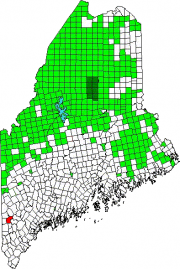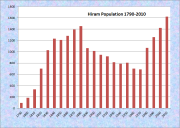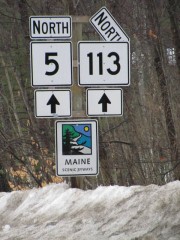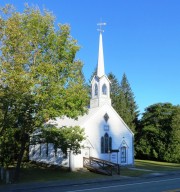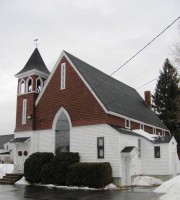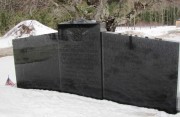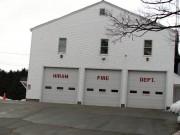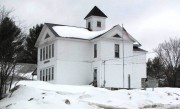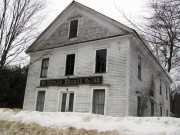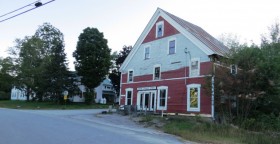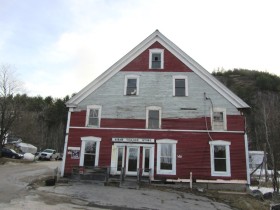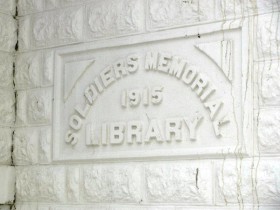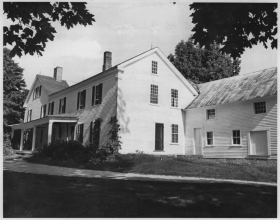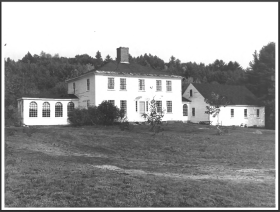| Year | Population |
|---|---|
| 1970 | 686 |
| 1980 | 1,067 |
| 1990 | 1,260 |
| 2000 | 1,423 |
| 2010 | 1,620 |
| Geographic Data | |
|---|---|
| N. Latitude | 43:54:18 |
| W. Longitude | 70:50:04 |
| Maine House | District 70 |
| Maine Senate | District 19 |
| Congress | District 2 |
| Area sq. mi. | (total) 38.8 |
| Area sq. mi. | (land) 37.5 |
| Population/sq.mi. | (land) 43.2 |
County: Oxford
Total=land+water; Land=land only |
|
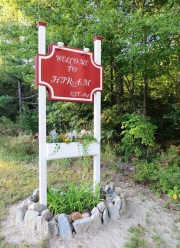 [HI-rum] a town in Oxford County, incorporated as a District on February 27, 1807. It was incorporated as Town on June 14, 1814, having been settled by the 1780’s, possibly as early as 1774. Hiram later annexed land from Baldwin (1821, 1844) and from Brownfield (1852).
[HI-rum] a town in Oxford County, incorporated as a District on February 27, 1807. It was incorporated as Town on June 14, 1814, having been settled by the 1780’s, possibly as early as 1774. Hiram later annexed land from Baldwin (1821, 1844) and from Brownfield (1852).
The name was inspired by the biblical King Hiram of Tyre whose kingdom was set among “timber of cedar and timber of fir.”
The Gazetteer of Maine in 1886 noted,There is much forest and a great variety of trees in this town. Along the streams and about the ponds are some tracts of good interval . . . . The soil is generally sandy loam. Hay is the principal crop. There are five sawing and planing mills, two grist-mills, one carding-mill, etc. The manufactures are long and short lumber, staves, shooks, men’s clothing, harnesses, liquid slating and blackboards, axe-helves, etc.
According to Brunelle,
This area was settled by Gen. Peleg Wadsworth, Revolutionary War hero who defended the Maine coast during British assaults on Castine. Wadsworth, grandfather of Henry Wadsworth Longfellow, was able to buy this land for a few pennies an acre after the war. His home, Wadsworth Hall . . . once served as Longfellow’s summer residence.
The villages of Hiram and East Hiram are divided by the Saco River, which winds through the town. Nearby Mount Cutler sports a hiking trail. Maine Routes 5, 113, and 117 serve the community. A chain of ponds hugs the western border above the village of South Hiram.
According to Northeast Historic Film, “Raymond Cotton was a storekeeper in Hiram, Maine. He owned a grocery store, and his wife, Marcia, ran a beauty shop in the space above the store. In addition to being a local grocer, Cotton was a blueberry farmer and member of the fire department.” Cotton, an author recounting local folklore, traveled widely and took many reels of home movies. They are in the Hiram Historical Society Collection at NHF, and include a 1938 segment on Maine blueberry farming. See the brief video clip then just close the new window tab to get back to the Encyclopedia.
At Hiram village the community buildings (churches, library, grange, museum, etc.) are clustered within walking distance. The historical society and the museum occupy the former Mount Cutler School building.
1944 photo from the George French Collection, Maine State Archives, Augusta, Maine
Form of Government: Town Meeting-Select Board-Administrative Assistant.
More Videos!
Additional resources
Brunelle, Jim. Maine Almanac.
Clemons, Hubert W. A Bicentennial History of Hiram, Maine, 1776-1976. Hiram, Me. Hiram Bicentennial Committee. 1976.
Cotton, Raymond C. By the Toss of a Coin: An Abridged and Updated History of the Town of Hiram. Hiram, Me. Hiram Historical Society. 1983. (Denmark, Me. Cardinal Printing Co.)
Cotton, Raymond C. Hog Reaves, Field Drivers, and Tything Men: The Birth Pains of the Town of Hiram. Hiram, Me. Hiram Historical Society. 1983. (Denmark, Me. Cardinal Printing)
Cotton, Raymond C. The Horse that went to Heaven (and other Hiram yarns). Hiram, Me. Hiram Historical Society. 1986.
*Maine. Historic Preservation Commission. Augusta, Me. Text and photos from National Register of Historic Places: http://pdfhost.focus.nps.gov/docs/nrhp/text/xxxxxxxx.PDF and http://pdfhost.focus.nps.gov/docs/nrhp/photos/xxxxxxxx.PDF
Teg, William. Hiram [by] William Teg. Cornish, Me. The Webb-Smith Printing Co. 1941.
Varney, George J. A Gazetteer of the State of Maine. 1886. p. 280-281.
National Register of Historic Places – Listings
Hubbard–Cotton Store
[Maine Routes 5 and 113 across Saco River from junction with Maine Route 117] The store is the most significant of the town’s commercial buildings. Its transitional Greek Revival-Italianate appearance is seen in the shallow window hoods and rather narrow cornice and corner boards. The unusually broad front and rather short main block are particularly unusual. These features and the overall scale combine with its prominent siting at a river crossing to make the building an important part of Hiram’s townscape.
The building occupies a site that was first developed about 1816 for a commercial business by Simeon Chadbourn. While there is no record of the destruction of the 1816 building, the detailing of the existing structure indicates its was built around 1850. The property was owned by John P. Hubbard in 1842, and members of his family were associated with the business with the exception of two years until 1886. That year Noah B. Hubbard sold the business to Lemuel Cotton and Son. The grandson of Cotton operated the store until 1987 when it was sold.
Inside, the store retains a high degree of integrity. The first story store/lunch counter area features exposed painted beams and sheathing with wooden support posts. As originally built the upper levels were unfinished although the second story was used to store grain. This was converted to an apartment in the late 1800s after the store was acquired by the Cotton family.
Known also as the Hiram Village Store, the building has been unoccupied at least from 2010 to 2014.
Soldiers Memorial Library
[85 Main Street] The Library is a one story, building designed by the Boston architects Robert H. Wambolt and Amos A. Lawrence in 1914. It was built with funds donated largely by Virginia Barker Jordan as well as local residents. The building is owned by the Town of Hiram and administered by a Board of Trustees. The Library is notable as one of only two in Maine built of ornamental concrete block. The bungalow-type building is a landmark among the wood frame homes and commercial structures that line the streets.
Although the town had multiple stores, churches and two fraternal organizations during the 19th century, there was no organized library. In 1901 Cassandra Clemons Twitchell led the movement to establish a town library. Three trustees were appointed to oversee the administration of the library, and $150 was appropriated by the town to procure books and print a catalog. An additional $75 worth of books were provided by the State. According to the first annual report of the library board, printed in the 1901-02 Annual Report of the Town, “a place for the books has been secured at the residence of Geo. W Clifford, and the library is now under the efficient charge of the librarian Mrs. Fanny M. Clifford.”
Soldiers Memorial Library (2012)
In 1901, in 1905, and again in 1913, the Library trustees unsuccessfully urged the construction of a building . Although the collections grew during the library’s first decade it was difficult for the Trustees to secure consistent lodgings for the collection, and it moved at least twice more. Finally, in 1914 the residents voted to set aside five hundred dollars for the building (in addition to the annual one hundred dollars appropriated for operating expenses). Donations were solicited and in that year $5,250 was pledged. The largest donation of $3000 (and many books) came from Virginia Barker Jordan, a Hiram native who lived in Portland. Jordan was the widow of James C. Jordan, the treasurer and general agent for the Star Match Company in Portland.
The Library and contains a tablet on which are inscribed the names of all the soldiers from Hiram who enlisted in the Revolution, Aroostook, War of 1812, Mexican, Civil and Spanish Wars. [See photos above.]
Wadsworth Hall
[south of Hiram] The Peleg Wadsworth House is a very simple country house. Far more important than the fact that the house is an early 19th century house are the people connected with its history. General Peleg Wadsworth, builder of the house, was born in Duxbury, Massachusetts in 1748. He moved to Portland after his graduation from Harvard College in 1768.
During the Revolutionary War, at the expedition against the fortress at Castine in 1779, Wadsworth was in command of the forces that landed on the peninsula of Castine. Although this expedition proved disastrous to the Americans, the General was exonerated of any wrongdoing.
In 1781 General Wadsworth was taken prisoner by the English at Thomaston. Imprisoned int the fortress at Castine and realizing that he was to be sent to England, he escaped two months after his capture.
Following the war, Wadsworth built the brick house on Congress Street in Portland. This house built in 1785-86 is now known as the Wadsworth-Longfellow Mansion and is owned by the Maine Historical Society.
In 1790, Wadsworth was granted 7800 acres extending from the Ossippee River to the Saco River in appreciation for his service during the Revolution. The General did not move in with his family until January of 1807 when work on the house was completed.
Since he was Hiram’s most prominent citizen, his house was often used for town meetings and various other functions. The room for this purpose was very large with a very high ceiling. The room was built so that General Wadsworth might drill the militia indoors during inclement weather and during the winter.
In 1808, the house in Portland was given to Stephen and Zilpah (Wadsworth) Longfellow, the parents of the poet, Henry Wadsworth Longfellow. [Richard D. Kelly photo]
Watson, John, House
[1 mile Northwest of Hiram off Maine Route 117] The oldest house in Hiram and a fine example of Georgian architecture, the John Watson was the home of one of the local pioneers who, in the years after the Revolution, greatly expanded settlements in southern Maine.
John Watson was born in 1750 and apparently came with his family as a child from England where they settled in the town of Arundel (now Kennebunkport). Watson served in the Continental Army in the early years of the Revolution. He and his family moved to a part of Brownfield now in the Town of Hiram. Watson built a rude home on the banks of the Saco River where he lived until 1785 when an unusually high spring flood swept away his home. He selected a new sight on higher ground east of the river and built the finely proportioned structure standing today.* [Earle G. Shettleworth photo]



